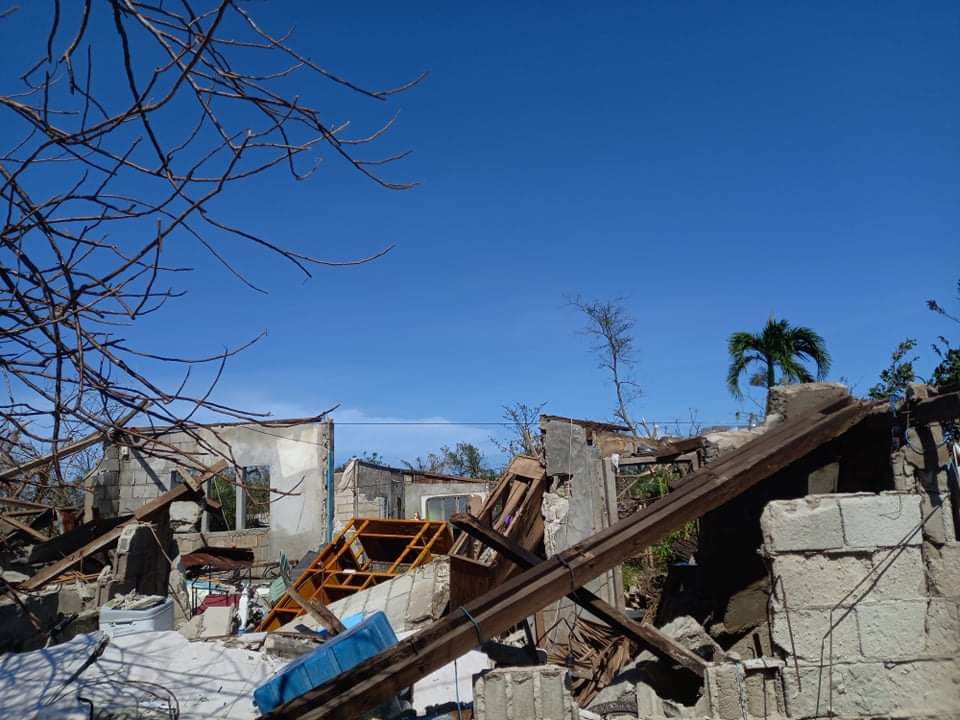Floating restaurants: Rebuilding, trying to stay afloat again in Olango

This is a photo of Topie and Dinah’s Floating Restaurant before Typhoon Odette. | Contributed photo
OLANGO ISLAND, Lapu-Lapu City, Cebu — Olango Island in Lapu-Lapu City has been known for its bird and marine sanctuary.
While some residents of the island worked on mainland Lapu-Lapu City and in other cities in Cebu, majority of them rely on tourism and fishing for their livelihood.
So when the COVID-19 pandemic hit and shut down the tourism industry in 2020, the residents were the most affected.
Then super typhoon Odette battered Cebu in December 2021, leaving havoc and ruin in its wake especially in Olango Island where the strong winds destroyed most of the houses there.
For the residents, it was a double whammy as they had lost their livelihood from COVID-19, and now, their homes were literally roofless as Odette’s fury blew away most roofs of Olango residents’ houses and even destroyed several of these houses.

Most houses in Olango Island in Lapu-Lapu City were destroyed when Super typhoon Odette slammed into the island on December 2021, as seen in this photo of houses in a barangay in Olango Island, days after Odette hit. | CDN digital file photo (Mary Rose Sagarino)
Aside from that, the floating restaurants, which have employed many residents specifically in Barangay Caw-oy of the island before the pandemic, were all destroyed or swept away at the height of Odette’s fury.
The floating restaurants were among the tourism destinations of the island and these structures were anchored at sea, dotting the area near the shoreline of Barangay Caw-oy on the eastern side of the island.

This is Armira and Cabana’s Floating Restaurant before typhoon Odette. | Contributed photo
These empty restaurants are a symbol of hope for residents of better days to come when the pandemic will be over or when the tourism industry in the country will again be open for visitors.
And after two years and just as things were looking brighter for the residents to work again and earn at the floating restaurants with the tourism industry starting to perk up, Odette came and snuffed out that hope.
And what was once an area in the sea off Barangay Caw-oy that was dotted with floating restaurants is now just an empty open sea.
Fortunately for the residents, few owners of the destroyed floating restaurants are ready to invest and rebuild their businesses.
One of the few, who started rebuilding his floating restaurant business in the area, is Topie Boloc-Boloc, owner of Topie and Dinah Floating Restaurant.
Topie said starting all over again was one of the most difficult things he had done since the effects of the pandemic and the typhoon had really hit the business hard.
He said he wasn’t able to prepare for both crises.
The restaurant has not been earning in the past two years because the floating restaurants have been closed due to the pandemic.
But still he believed that things would turn out for the better once the pandemic would end, and so he took care of the empty floating restaurant, maintaining it so that it would be ready to open for business when tourists would visit the island again.
Then Odette came.
And since he was not expecting Typhoon Odette to be that strong, he left everything he needed for the business in his floating restaurant and sought shelter on land.
And just like that in a span of a few hours, the floating restaurant he built for and nurtured for 16 years was gone amid Odette’s fury.
Still he believed in the business that the foreign tourists, who was his main market at the time before the pandemic happened would return.
So he is again investing in the floating restaurant business, despite chances of more typhoons that may destroy the floating restaurant again.
“Olango has been known for tourism and fresh seafoods,” said Topie, who believed that this was more than enough motivation to rebuild his business.
And because the restaurant has been closed in the last two years, he really did not have the ready funds to rebuild it.
So he has to borrow money, applied for loans, and sold a few properties to raise the P3 million needed to restore the business.
But now he also learned that it would also be better to have a restaurant business on land and not just on the sea so that if a super typhoon like Odette would come and destroy the floating restaurant he could still find a way to earn money.
“Dili gyud diay ta kasalig aning negosyuha. Maayo sad diay nga maghinay og negosyo nga dili sa dagat kay labi na og naay bagyo, dili ta ka operate,” said Topie.
(We cannot really depend on this business all the time. It is also good to slowly have a business on land because if there is a typhoon, I can still operate and earn.)
Meanwhile, Henry Apa, assistant supervisor of the Armira Cabana Floating Restaurant, is hopeful that the restaurant owner will rebuild the business so that he and the others will have jobs again.
Apa said they were also not able to prepare for the typhoon.
In fact, the manager of the restaurant, a Chinese national, stayed in the floating restaurant because he was confident that the structure was big and dependable.
Apa said they tried to convince him to evacuate the place but he just ignored them.
The Chinese national was one of the individuals, who died in Lapu-Lapu City because of the typhoon. The floating restaurant was rented by a Chinese for 20 years.
Apa said Kuya Nik, who was the original owner of the restaurant, told them he would start to restore the floating restaurant within the year.
“Lipay kay para naa nami trabaho kay mao gyud to amo gisaligan,” said Apa on the restaurant owner’s plan to rebuild the business.
(We are happy because for us, we will have jobs, which we have depended on for our livelihood.)
He said after the typhoon and when the floating restaurant was swept away and destroyed, he would go out to sea and fish to earn and to have food on the table.
His children, who are working, also helped.
Apa said one of the things he learned of the crises was to save money even just a little as a preparation for any disaster.
Apa and the owners of the floating restaurants hope that more tourists will visit the island again.
As a preparation for the expected visitors, the owners and their employees are already vaccinated.
Topie also said that on April 8, his restaurant had already opened and started accommodating guests, serving them fresh seafood with a refreshing and relaxing view of the sun, sea and sky or perhaps, the moon, sea and the sky adorned with stars.
RELATED STORIES
DOT: Central Visayas tourism back on track
Cebu ready to welcome foreign tourists again
Foreign tourist arrivals steadily rising
Chan, Marina reps tackle water transport problem in Olango
Odette leaves 9 dead; 12 missing in Lapu-Lapu – Chan
Olango 50% energized, says MECO exec
/dbs
Disclaimer: The comments uploaded on this site do not necessarily represent or reflect the views of management and owner of Cebudailynews. We reserve the right to exclude comments that we deem to be inconsistent with our editorial standards.

